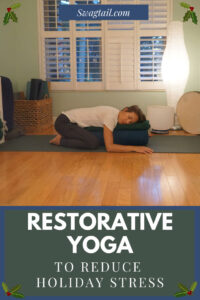 The holidays are a festive time of year to celebrate with family and friends. Yet these joyful additions to your already-full schedule can put a strain on your energy levels. This can result in doubting your capability to meet the demands at hand–much less give generously to those you love in this season when it’s expected most. That’s why you can do restorative yoga to reduce stress. Just 60-minutes on your mat will restore your vitality, boost your immune system, and put you back into alignment so you can show up authentically with an open heart.
The holidays are a festive time of year to celebrate with family and friends. Yet these joyful additions to your already-full schedule can put a strain on your energy levels. This can result in doubting your capability to meet the demands at hand–much less give generously to those you love in this season when it’s expected most. That’s why you can do restorative yoga to reduce stress. Just 60-minutes on your mat will restore your vitality, boost your immune system, and put you back into alignment so you can show up authentically with an open heart.
This week’s sequence is a change of plans.
I was actually going to post a twisting chair yoga sequence this week to cleanse the body after an over-indulgent Thanksgiving week.
However, I found that it wasn’t my body that required the extra TLC. My mind needed a reboot. Instead of a vigorous flow on my mat, I needed more quiet. I also wanted to rest after a week of baking, parties, golfing adventures, and later-than-usual bedtimes.
And I know that many more of these fun times lie ahead this December.
That’s why I’m giving you my go-to restorative yoga sequence right now. I use these poses to sleep better at night. I’ll often use it in the afternoon for an energetic kick. My hope is that you’ll enjoy it as much as I do!
WHAT IS RESTORATIVE YOGA?
Restorative yoga is a relaxing, supportive practice that reprograms the nervous system.
This is done by gently stimulating different organs and portions of the body with a gentle stretch.
Numerous props are used to assist this process. This means that no effort is necessary as you restore the body’s natural capacity for health.
On the surface, restorative yoga appears similar to a yin-style practice. Both hold postures for a longer period of time at a fraction of your total capacity. And while the body does physically open as a result of these held asana-s, the goal of restorative yoga is not to lengthen the tissues. Instead, it’s to help regulate the nervous system.
BENEFITS OF RESTORATIVE YOGA?
While I’m using restorative yoga right now to reduce holiday stress,there are a number of amazing benefits that accompany a restorative practice. These include:
- More resilience in the nervous system
- Improved immune function
- Increased blood circulation
- Greater endorphin secretion (which boosts a sense of well-being)
- Heightened levels of self-awareness
- More balanced emotions
Plus, restorative yoga helps to:
- Lower cortisol and adrenaline production in the body (that result from stress)
- Reduce muscle tension
- Eliminate self-doubt and worry
- Less resistance to the unknowns in life
You can start to receive these benefits (and more) with this 60-minute yoga sequence.
Props Needed:
- Wall Space
- Bolster (or stack of blankets/beach towels)
- Strap
(1) SUPTA UPAVISTHA KONASANA AT THE WALL
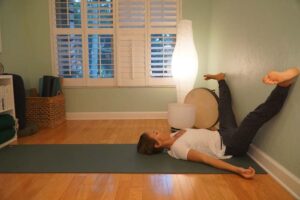
Purpose: This entire sequence begins with an inversion. This is because getting upside down immediately shifts your perspective. The circulation effortlessly brings blood back to the heart. Your nervous system begins to calm down (which, as you know, is the main benefit of restorative yoga). Plus, the hips open and the low back begins to release any held tension from the day.
Length: 5-10 minutes
Additional Notes:
- Move the hips further from the wall to ease any tension on the backside of the legs.
- Place blocks underneath your legs, or a bolster under the hips, for additional support.
- Wear socks to keep your feet warm from the start of practice.
- Use a blanket to stay warm as well.
(2) SUPTA MALASANA AT THE WALL
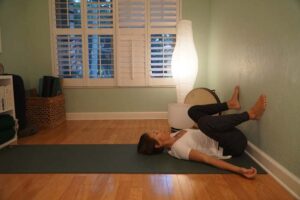
Purpose: Malasana, also known as a squat position, can be a challenging pose in an active yoga class. This is due to the stretch on the ankles, calves, and low back. Yet, when done in a supine position, that strain is alleviated and you can gain all of the same benefits without the effort. Some of these benefits include improved digestion, more circulation in the hips, and relief of low back pain.
Length: 4-6 minutes
Additional Notes:
- Move away from the wall to make the pose more accessible.
- Breathe into the connection between your feet and the wall. This can increase your sense of calm and single-pointed focus. This is especially important to reduce holiday stress that comes from your mind being pulled in many directions.
(3) RECLINED TWIST AT THE WALL
Purpose: The previous poses started to alleviate low back tension. Now, you can take this openness into a twist that targets more of the spine. One additional benefit of doing this at the wall is that the bottom of your feet have contact with a surface. This can increase your sense of groundedness.
Length: 5 minutes each side
Additional Notes:
- Use props to make the pose accessible. You can place blankets under the bottom knee, or put a block between the knees, to make the posture more comfortable.
- Melt the backside of both shoulders on the ground.
- Scoot your bottom away from the wall to make the twist easier.
- Cactus the arms to add more energetic flow into the heart and shoulders.
Come back to center before moving on to the second side.
(4) SUPPORTED CHILD’S POSE
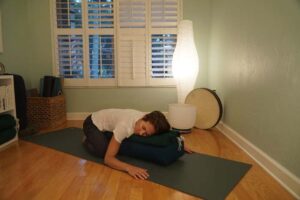
Purpose: Supported child’s pose is a welcome invitation to turn inward and reduce the holiday stress that so often accumulates from busy-ness in the outer world. Plus, it’s a simple pose to further alleviate low back tension and stimulate digestive organs–both areas of the body that can harbor strain this time of year.
Length: 4-6 minutes
Additional Notes:
- Switch the direction of the head halfway through the pose.
- Focus on sending the breath into the back of the body.
- Place a bolster and as many blankets as possible underneath the torso for support.
(5) SUPPORTED DEER POSE
Purpose: Twists are a great way to wring out tension in the body and soothe the mind. That’s why this second round of twists is in place here to further reduce holiday stress. The physical benefits of this pose include an opening of the hips and improved digestion. It also opens up the more subtle aspects of the kidney meridian. The result is greater functionality of the kidneys, throat, and lungs.
Length: 5-7 minutes each side
Additional Notes:
- Prop up the torso with a bolster and/or blankets.
- You can rest more upright for the first minute here before folding into the twist. Just remember to keep the arms steady so as little effort is used as possible. You can also stack numerous props to lessen the twist.
- If you prefer the legs closer together, this can make the pose more accessible too.
Counterpose: Pause on your back in constructive rest or another round of supportive child’s pose between sides.
(6) SUPPORTED SUPTA PADANGUSTHASANA, RIGHT LEG
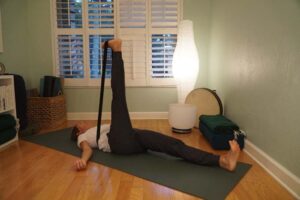
Purpose: Supta Padangusthasana is also known as reclined hand-to-big-toe pose. On a physical level, this posture relieves compression and tension in the low back. It also opens up the hamstrings. In fact, this might be the most active pose in the entire sequence.
Yet, with the strap behind the back (at the place just above the kidneys), the effort in the pose is alleviated. And you can continue to reduce holiday stress with this mild inversion.
Length: 5 minutes
Additional Notes:
- Get a longer strap, like the one in our holiday gift guide for yogis, to make this pose more accessible.
- Bend the bottom knee and place the sole of the foot on the floor to ease the hamstring stretch on the extended leg.
- The strap can also be placed behind the head to create a neck release as well.
(7) SUPTA PARIVRTTA PADANGUSTHASANA, RIGHT LEG
Purpose: The hamstrings are elongated based on the wall pose at the beginning of the sequence and the stretch just moments ago prepares you well for this twisted posture. And whether you keep the top leg extended or not, you’ll get a refreshing spinal rinse here. Microcirculation is restored around the spinal discs and intercostal muscles also lengthen to make breathing easier.
Length: 5 minutes each side
Additional Notes:
- You can pause with the top leg just ⅓ of the way across to target the outer hip before taking the twist.
- Make the posture easier by letting go of the strap entirely. Simply bend the knee, place the shin on a bolster or stack of blankets, and let the shoulders melt into the ground.
- Keep relaxing the body more and more with each exhale.
(8) REPEAT 6 & 7 ON THE LEFT SIDE
Purpose: Balance out your body by taking the same postures on the left side. You can pause in savasana or constructive rest before doing so if you’d like.
Length: 5 minutes in each posture
SUPPORTED SAVASANA
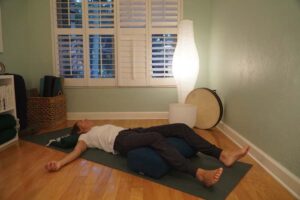 Purpose: Restorative yoga is almost like an extended relaxation practice. So by the time you actually get to corpse pose, you have already created the mental and physical space in which to rest. As you’re here, breathe consciously at first. Then ease your way into effortless breath, so the body can fully absorb the benefits of the practice.
Purpose: Restorative yoga is almost like an extended relaxation practice. So by the time you actually get to corpse pose, you have already created the mental and physical space in which to rest. As you’re here, breathe consciously at first. Then ease your way into effortless breath, so the body can fully absorb the benefits of the practice.
Length: 5-10 minutes
Additional Notes:
- Use a neck roll to add more relaxation to the upper spine, throat and jaw. Just make sure the roll is the right size so that the back of the head rests comfortably on a blanket or your mat.
- A bolster or stack of blankets can be placed under the knees to add even more support for the low back.
- Use an eye pillow, put on a pair of socks, or cover yourself with a fuzzy blanket to reduce holiday stress at an even deeper level.
- Take a side-lying savasana if you are more than 3 months pregnant.
PUTTING IT TOGETHER
Restorative yoga balances the nervous system, calms the mind, and improves immune function. You can use it any time of the year to gain these benefits and more! Yet, we suggest you use this sequence to reduce holiday stress right now. The best part is you’ll be able to love authentically and give generously from your place of inner alignment.
Take Action Now:
- Download the sequence above and use this class on your own (or with your students).
- Share your favorite poses that reduce holiday stress in the comments section below.


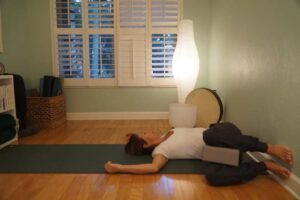
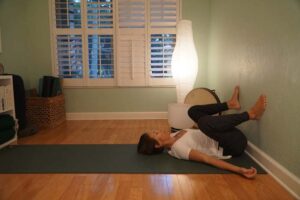
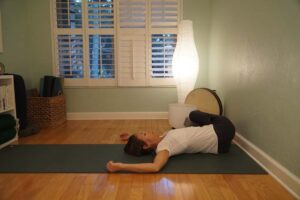
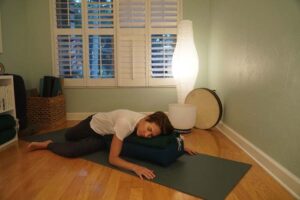
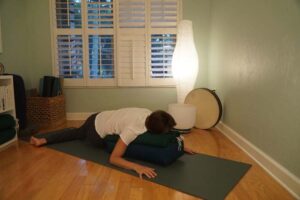
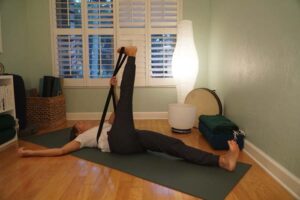
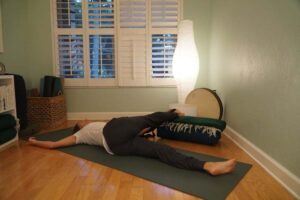
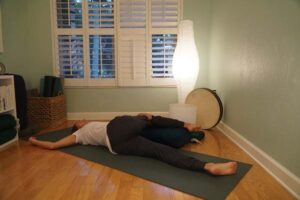
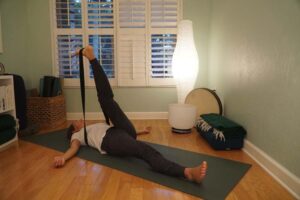
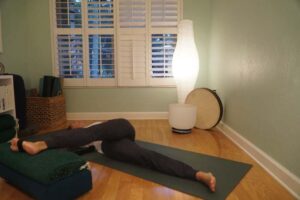
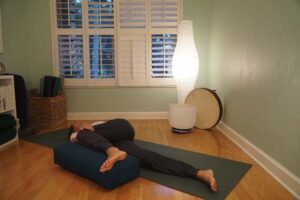

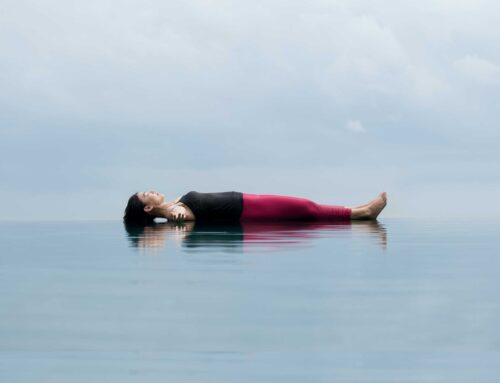

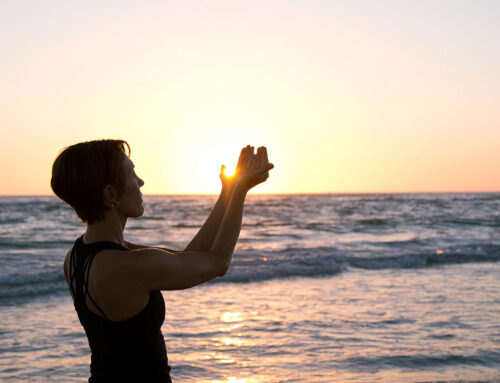
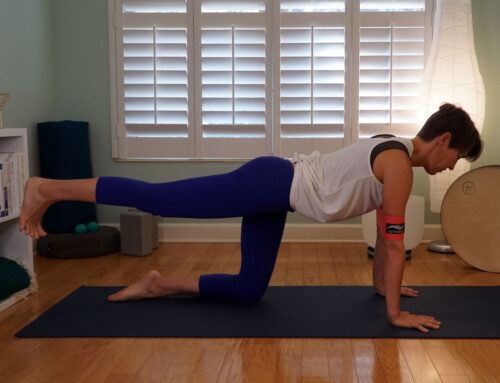
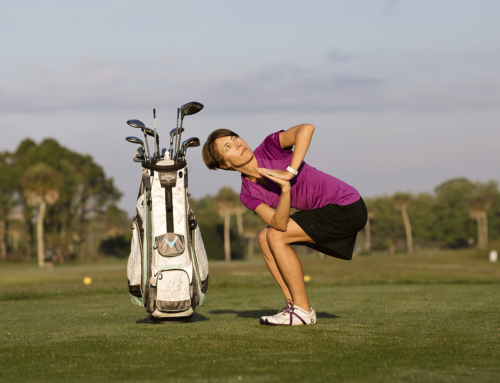
Leave A Comment